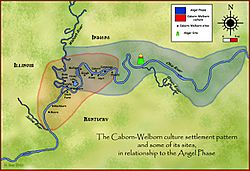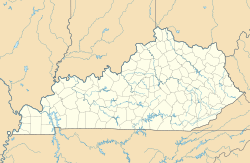Slack Farm facts for kids

Caborn-Welborn culture and some of its larger sites. Slack Farm is on the southern bank of the river.
|
|
| Location | Uniontown, Kentucky, Union County, Kentucky, |
|---|---|
| Region | Union County, Kentucky |
| Coordinates | 37°46′11.03″N 88°0′28.12″W / 37.7697306°N 88.0078111°W |
| History | |
| Founded | 1400 CE |
| Cultures | Caborn-Welborn variant of the Mississippian culture |
| Site notes | |
| Architecture | |
| Architectural styles | Platform mound |
| Responsible body: private | |
Slack Farm (also known as 15 UN 28) is an important archaeological site. It belonged to the Caborn-Welborn people, who were part of the larger Mississippian culture. This site is found near Uniontown, Kentucky, close to where the Ohio River and the Wabash Rivers meet.
The Slack Farm site once had a Native American mound and a large village. People lived here between the years 1400 and 1650 CE. Slack Farm was known as a major village for the Caborn-Welborn people. However, it became famous in 1987 when it was badly damaged by people who dug there illegally.
Contents
What Was Slack Farm Like?
The Slack Farm site is located on a raised area of land near the Ohio River. There was also a mound on a bluff overlooking the site. The Slack Farm village itself had seven separate living areas. These areas were built around a central open space, covering about 14 hectares (about 35 acres). A small valley cut through the site from west to south.
Homes and Food Storage
The houses at Slack Farm were typical Mississippian homes. They were rectangular and built using a method called wattle and daub. This means walls were made from woven branches covered with mud. Many homes had special clay fireplaces inside. Near most houses, there were large pits. These pits were used to store corn and other dried foods. They were big enough to hold enough food to feed 7 to 12 people for a whole year!
Ancient Burial Grounds
Each part of the large village had its own cemetery. People were usually buried lying flat. They were often placed in neat rows, and it seems like the graves were marked. This is because new burials did not overlap older ones.
Items like stone pipes, shell beads, and small pottery jars were often buried with people. These items were usually placed near the upper body. Later, during the Late Caborn-Welborn period, European trade goods were also found in graves. These included glass beads and copper or brass bracelets.
The 1987 Damage and Its Impact
In 1987, a group of people paid money to a new landowner at Slack Farm. They wanted to dig at the site without permission. These individuals used a tractor and spent two months causing a lot of damage. They disturbed many ancient Native American graves and destroyed parts of Mississippian culture homes and other historical objects.
Local people in Uniontown noticed what was happening. Their complaints led to the arrest of those involved. They were charged with damaging a historical site. At that time, the laws about protecting ancient sites were not as strong. However, the controversy over Slack Farm helped change that.
Stronger Laws for Protection
The damage at Slack Farm played a big part in creating stronger laws in Kentucky. These new laws protect ancient burial sites, sacred grounds, and other archaeological sites. The harm done to Slack Farm also caught attention around the world. It was even written about in National Geographic Magazine. This led to many people speaking out against the illegal removal of ancient artifacts.
Native American groups later reburied the disturbed remains. Even today, Native American groups gather in the area. They do this to remember the site and to mourn the damage that was done.


